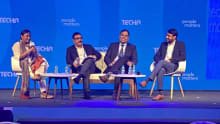Evolution of recruitment: A talk by Paul Dupuis, CEO Randstad India
The speaker Paul Dupuis, CEO Randstad India has been working in Asia for 27 years and in this presentation talks about how recruitment has evolved and the relevance of talent acquisition in India. You can also watch the session video.
Let’s begin from the beginning
Paul Dupuis begins with a relevant question i.e. ‘when did recruitment begin’ to which an interesting answer bounced off from the audience: ‘with Eve’. Paul agrees that this could be worth a philosophical debate and during his presentation takes us to the Caesar era. He says that it all began in 55BC when Julius Caesar decreed that any soldier who introduced a new soldier to his army will get a referral fee of 300 Sestertius! He says that Julius Caesar figured out what we are still dealing with today which is to say that ‘referrals are golden’ and that it is quite close to ‘employer branding’.
Moving on he also cites World War II where there was an extreme gap of talent since people were all off to war. At this point, the staffing agencies merged in the formal or semi-formal way and so the government stepped in.
A flashback to ROLODEX
He asks the audience if they remember using a Rolodex. He elaborates and enlightens the young workforce saying that it represents connection and today is replaced by social networking. He reminisces and says that when he started out he had zero cards in his Rolodex, but built his network pretty much the same way as the current generation does.
He says nothing has changed – the skills that made us successful in the past, as was the case with Julius Caeser, will make us successful in the future. Of course, the mediums have changed vis-à-vis technology, but basic qualities are creativity, ingenuity, and connecting.
The present: On the death of recruitment post LinkedIn?
On the contrary, he argues that LinkedIn has created more jobs. He goes on to say that we need to appreciate technology for it’s a great tool for recruitment. Ironically, Japan that is technologically far more advanced is also a ‘lagger’ in technology. He says LinkedIn has the lowest penetration rate in Japan; 1.3million users only in a country of 130 million population as compared to Singapore where they are 4 million users in a population of 6 million. The reason is that Japanese candidates behave differently and so is the case in India. It is here that he goes on to make a connection between leveraging technology and localizing experiences to engage people. For instance, in India, while Facebook is popular, YouTube has more fan following. And, that he says can be leveraged to attract candidates. He adds that leading companies are in fact using YouTube to build their brands, form communities. Every time someone likes your video they are a part of your talent community. Worth a thought, no?
GigWalk in Japan
Paul touches upon how GigWalk worked for Randstad in Japan. Here’s something which gives you a gig that gets you an e-payment and that he says quite worked in Japan because a) there was a demand for such gig work from employers and b) there were takers. He calls this talent acquisition of a kind which comes into existence with the help of a creative approach; we modified technology (the GigWalk app) to the needs of the talent and employers. Now, Randstad has 7,000 registered people on GigWalk. Quite an accomplishment from zero until a few months back?
Who is winning the battle of talent acquisition?
Leading companies that are consciously working to create talent communities are winning the race of talent acquisition. He says that increasingly HR leaders are partnering with IT and marketing to create employer brand and strategies to establish a market and own that community. He reminds the audience of Julius Caesar who encouraged referrals. To make this point clearer he makes a correlation between happy/unhappy customers and employees. Saying that in e-commerce, a happy customer tells 16 people while an unhappy one tells three times that. Same happens with the talent you are engaging with regardless of whether you hire them or not.
Insourcing vs outsourcing
He rewinds a bit and talks about Japan where he balanced out the insourcing and outsourcing through a creative solution. He recalls two clients that wanted to get CAD work done but said it wouldn’t be regular and that they didn’t want full-time employees. As an answer to their question Randstad hired 100 people and set up a CAD station. Initially, he says that they planned on hiring young talent and training them, but upon seeing the application they were quite surprised. The most popular in the candidate pool was Japanese housewives. Owing to this Randstad modified their strategy. Allowed mothers to continue with their chores, come to the office to work and head back home. What Randstad also did was to set up a day care. And, as Paul says ‘we insourced’. Creative, indeed.
Omnichannel marketing
In the e-commerce industry, buyers touch opportunity several times during the day and the same happens in talent acquisition. He urges us to know how we are touching them or which channel is working for you. Are we touching them organically or reaching out to someone who is helping us create those touch points?
Concluding note
Paul touches upon an important point. He says, “Despite so many Indians graduating every year yet the skill gap is widening and our role is to close that gap, get the best people, leverage technology, help do innovative things, create employer brand, create talent community that you can leverage because we know people are an important part of our business.”











